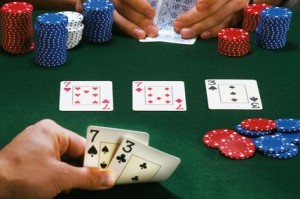The social and psychological game of Texas Hold’em can be a daunting aspect to master. The understanding of mathematical probability is only one small piece of the puzzle. This article is a continuation on the basics of reading other players and identifying their strengths and weaknesses. Most of the players you encounter will be easily defined as passive or aggressive. The focus of this article is on the aggressive player who can be further categorized again as tight or loose.
 Aggressive opponents are in general, the players at any table that are doing most of the betting and raising. They are more likely to bluff or bet big and for the most part they are controlling the play tempo and the size of every pot. Sometimes they are “slow playing” a hand and will try just calling, but this is against their nature.
Aggressive opponents are in general, the players at any table that are doing most of the betting and raising. They are more likely to bluff or bet big and for the most part they are controlling the play tempo and the size of every pot. Sometimes they are “slow playing” a hand and will try just calling, but this is against their nature.
A Loose-Aggressive player is the maniac and in my opinion is the most volatile of opponents. A loose-aggressive approach to gaming is like walking the razor’s edge, and can easily leave you busted. Although there are some successful loose-aggressive players out there, most are not, especially at the lower to middle limit games where people are commonly going too far with hands anyway and are not so easily pushed out on a bluff. Loose-aggressive opponents can really wreak havoc at any table but are always welcome because they create action. When faced with one of these guys hold back and play tight. Wait for them to make the mistake of betting too heavy against your winning hand. Limp in and then bet big when they feel stupidly “pot committed”.
A Tight –Aggressive player is someone that plays hands very selectively but when they do decide to play a hand, watch out! They will bet big and you can be almost certain they have a strong hand. Once an opponent of this type has been identified, avoid direct confrontations with them unless you got more than a couple of good hole cards. This is a solid winning approach to hold’em but most of these players are too predictable for their own good and can easily be manipulated with a good bluff or a slow play. This weakness is ultimately the approach’s downfall.
The correct approach to any poker game is to not using the same style of play too often. Adjusting your play style will keep your opponents off balance and unable to adjust. By paying attention to what’s happening you can anticipate dramatic changes and read any player with deadly accuracy. Remember that these are generalizations and a tight player may quickly become loose after losing a big hand or a loose player may win big and start playing tight.
